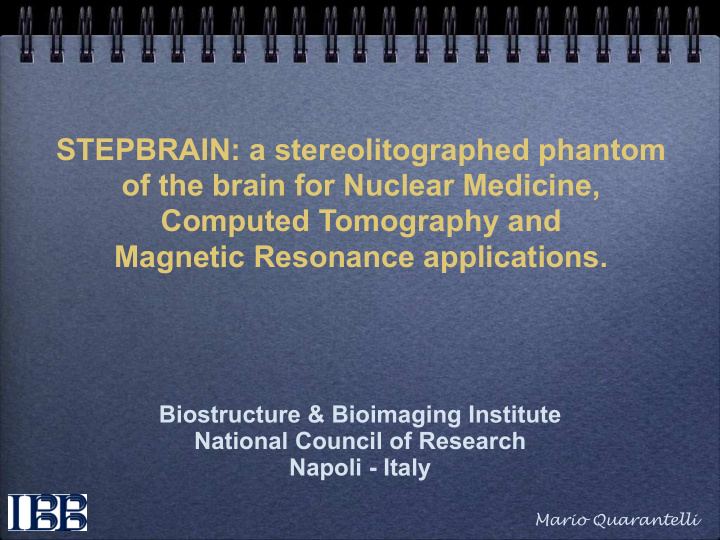



STEPBRAIN: a stereolitographed phantom of the brain for Nuclear Medicine, Computed Tomography and Magnetic Resonance applications. Biostructure & Bioimaging Institute National Council of Research Napoli - Italy Mario Quarantelli
STEPBRAIN Introduction: This phantom has been designed to validate different techniques for partial volume effect correction in low-resolution images. It was carried out within PVEOut, an EC co- financed project (QLG3-CT2000-594) 2
STEPBRAIN Phantom requirements: To simulate human brain architecture as seen in NM allowing for separate filling of GM, WM and CSF. To simulate as accurately as possible brain architecture as seen in MRI with minimum possible wall thickness and with maximum possible adherence to complexity of brain tissue shapes. 3
STEPBRAIN Methods and Materials: It was built by a rapid prototyping technique applied to a digital model derived from a 1.5T MRI dataset of a 35 y.o. normal volunteer composed of 150 3mm-thick partially overlapping slices (1mm increment) covering the whole brain. 4
STEPBRAIN Methods and Materials: For each slice location T1-, PD- and T2- weighted spin-echo images were obtained, and segmented into GM, WM and CSF using a multiparametric technique (Magn Reson Med 1997;37:84). 5
STEPBRAIN Methods and Materials: The subsequent processing of the segmented images by homemade and industrial software included: manual editing of the basal ganglia to ensure their connection with GM to allow proper filling; filling of the vessels located inside the parenchyma with the tissue type that occur most frequently on the surrounding pixels; final elimination of "isles" of pixels inside a tissue type not connected in 3-D with other pixels of the same type; 6
STEPBRAIN Methods and Materials: Processing of the segmented images by homemade and industrial software included: a 5x5x3 median spatial filtering of the entire volume to smooth the boundaries of the tissues; conversion of the binary file into a vectorial representation of the surfaces; creation of the hollow of GM and WM compartments defining the separation 1.5mm-thick walls separating the three compartments; adding of tubes to allow filling of GM and WM compartments. 7
STEPBRAIN Methods and Materials: Processing of the segmented images by homemade and industrial software included: a 5x5x3 median spatial filtering of the entire volume to smooth the boundaries of the tissues; conversion of the binary file into a vectorial representation of the surfaces; creation of the hollow of GM and WM compartments defining the separation 1.5mm-thick walls separating the three compartments; adding of tubes to allow filling of GM and WM compartments. 8
STEPBRAIN Methods and Materials: The resulting file was used to drive a stereolitography machine that polymerized a hydrophobic resin with a laser beam in regions corresponding to the walls, providing the final phantom. 9
STEPBRAIN Methods and Materials: GM and WM compartments were then filled with solutions with different isotope concentrations for PET/SPET scanning (4/1 ratio to simulate GM/WM contrast), while different Mn-Gd concentrations were used to simulate different GM/WM relaxometric properties. 10
STEPBRAIN Results: The resulting phantom at the current wall thickness proved to be waterproof , with no communication between GM and WM compartments, and suitable for CT, MR, PET and SPET scanning. 11
STEPBRAIN CT 12
STEPBRAIN PDw T2w T1w 13
STEPBRAIN SPET 14
STEPBRAIN Conclusion: We have shown the feasibility of an anthropomorphic phantom suitable for multi- modality (nuclear medicine and MR/CT) imaging, using stereolitography. 15
STEPBRAIN 16
STEPBRAIN 17
Recommend
More recommend